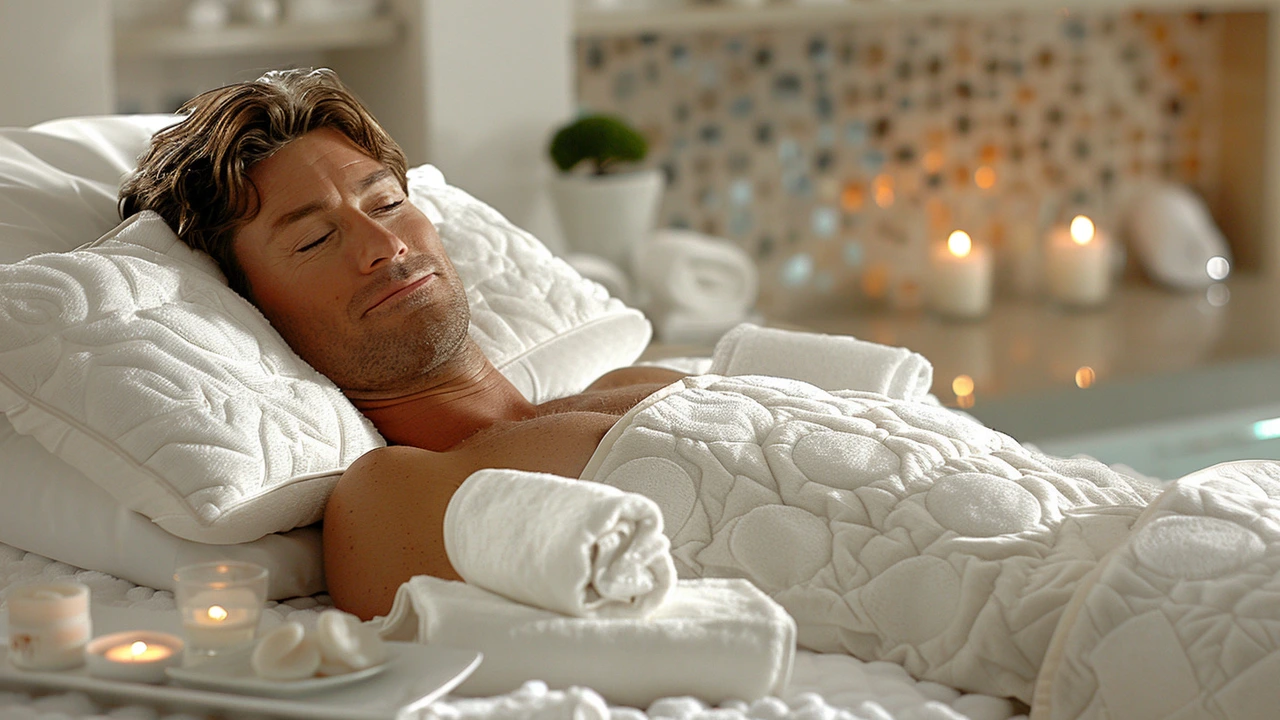Exploring Palliative Massage: The Intersection of Comfort and Science in Healing
 Dec, 28 2023
Dec, 28 2023
The Intriguing Intersection of Massage and Palliative Care
Now, who would've thunk that the simple act of rubbing someone's back could amount to more than just an affectionate gesture? Turns out, it can be a profound element of palliative care - it's not just your mundane, everyday back rub, it's palliative massage, folks! This intricate tango of touch and therapy wraps a blanket of relief around those grappling with serious illness, and believe it or not, it's backed by science. We've come a long way from thinking that massage is merely an indulgence for the ones hitting the spa!
Imagine the warmth and comfort a "hello" from my Siamese pal Whiskers brings on a blue day. That's merely a feline’s meow, right? But there's healing in that silky touch. Now, amplify that to the dedicated and thoughtful strokes of a massage therapist charged with ebbing away the physical and emotional pain of someone in palliative care. It's not about kneading dough here; it's a conscientious, methodical approach that speaks directly to the body's own healing mechanisms. So, folks, let's delve into the meat and potatoes, or should I say 'muscles and sinews,' of this wonderful therapy.
The Compassionate Science Behind Palliative Massage
It's high time we unravel the shroud of mystery surrounding palliative massage and understand the nitty-gritty of why it's not just a feel-good rubdown. It's about activating the nervous system in a way that's like coaxing a cat out of its hiding spot - gentle and calculated. I'm talking neurotransmitters, I'm talking hormones - this isn't hocus-pocus, it's scientifically verified stuff! We're tossing around terms like oxytocin and endorphins like they're confetti at a parade, because, in essence, they are the body's natural party-starters that palliative massage invites to the scene.
Picture this: my Golden Retriever, Buddy, when I scratch his belly, all his worries (about where his next treat is coming from) dissipate like dew in the morning sun. That's a bit like what palliative massage does, but for humans and on a supremely sophisticated level. By targeting specific areas of the body and applying maneuvers steeped in anatomical and physiological wisdom, therapists can potentially ease symptoms like pain, anxiety, and fatigue. And who doesn't want a slice of that relief pie?
Elements of Palliative Massage Etiquette
One does not simply start kneading a person like bread dough; oh no. There’s an elegance to it, a finesse, if you will. Think of palliative massage as the equivalent of a well-choreographed ballet. Each touch should be as considerate and deliberate as if one were turning the pages of a rare, old book you just discovered in the attic. This dance of hands requires a thorough understanding of the individual's specific needs – not unlike the way I have to finagle the exact spot on Whiskers' back that gets that purr motor running.
There's more to it than just slapping on the oil and going to town; it's about creating an environment where even the air whispers, "Relax, you're in good hands." Literally. Everything - from the lighting to the room temperature, the soundscape to the choice of oils - is orchestrated to lull the senses into a state of serenity. We aren't just fluffing pillows here; we're preparing a sanctuary where comfort reigns supreme.
Techniques and Modalities: The Breadth of Palliative Massage
Hold your horses, it's not just about the Swedish strokes we all know and love. When entering the realm of palliative massage, you're welcomed by a smorgasbord of techniques, each with its own charm and healing potential. We've got the gentle reassurance of aromatherapy, the ancestral wisdom of acupressure, and the rhythmic lull of lymphatic drainage. Then there's reflexology, which is like hitting the jackpot on a slot machine, except the winnings are measured in relief and relaxation.
These techniques are so diverse, they could easily represent the array of treats at your favorite bakery; delicate, bold, indulgent, meticulous - there's something suited for every palate, or in this case, every therapeutic need. Whether it's the systematic pressure of a deep-tissue massage addressing pain or the tender caresses of a relaxation massage easing anxiety, there's a modality on the menu for every course of the palliative care journey.
Understanding the Emotional Resonance of Touch
Did you know that human touch can sing? Not literally, of course - though wouldn't that be something? But in the way it communicates, the silent melody of touch plays a poignant tune that can resonate within the soul. It's a reminder that you're not alone, not just a physical being but someone's son, daughter, friend—human connection in its purest form. And when you’re undergoing the trials that come with severe illness, that touch is a lifeline to the world around you.
There's an art to reading the unspoken language of the body, akin to discerning the moods of Whiskers – it’s all in the whisker-twitch and the tail-flick, you see. When a massage therapist translates this corporeal dialect through their hands, it's not just about physical alleviation; it's a conversation that says, "I see you, I'm with you, let's walk this path together." It's the holding of a hand, the wiping of a brow, the simple but profound affirmation of presence.
The Pivotal Role of Palliative Caregivers and Family Participation
Let's not forget the unsung heroes in both palliative care and palliative massage – the caregivers. They stand as stalwart companions, often bridging the gap between the professional touch of the therapist and the personal touch of a loved one. And sometimes, these caregivers could benefit from a little crash course in palliative massage techniques. That's right, it's not just for the pros with the magic hands; with a bit of guidance, hands that rock the cradle can also soothe the spirit.
Amelia and I often give each other simple shoulder rubs after particularly long days, and let me tell you, it feels like someone hit the reset button on my stress levels. Now imagine gifting that sensation to someone who needs it like they need air. It's a token of love, an invisible yet palpable thread that ties us to each other. It empowers caregivers, knitting them ever closer into the fabric of healing and comfort that envelops the patient.
Palliative Massage in Practice: Real World Implications
Rub-a-dub-dub, let's talk about putting this into practice. It's one thing to preach the gospel of palliative massage from the comfort of an armchair (Whiskers curled up by my side, of course), but the theatre of operation is where the real magic happens. These therapeutic touches find their way into hospitals, hospices, and homes, each setting lending its own unique tempo to the dance of healing.
In these environments, you'll witness the symphony of care in its fullest expression. A range of professionals, from massage therapists to doctors and nurses, each playing their part with the precision of a maestro – it's like watching a Cirque du Soleil performance, where every acrobat, juggler, and clown (metaphorically speaking) is in perfect sync. It’s all about giving those facing the final curtain a quality of life encore that befits their dignity and humanity.
Embracing the Future: Innovations and Opportunities in Palliative Massage
The field of palliative massage isn't just lounging on its laurels like a cat basking in the sunbeam of past achievements. Oh no, it's constantly stretching, growing, exploring new techniques and innovations like my Buddy chasing his tail, but with a tad more grace, I'd like to think. As research unfolds and sheds new light on the intricacies of palliative care, massage therapy is eagerly standing by, ready to adapt and incorporate fresh insights into its practice.
We're talking technological advances that can enhance traditional methods, education programs that weave the threads of compassion and scientific understanding into a rich tapestry of care, and policy shifts that recognize the value of holistic approaches. The horizon is bright – and we're not just gazing at it, we're striding towards it with purpose. The promise of a future where palliative massage is as integral to care as medicine and nursing is not only an enticing vista but a very real possibility.
To wrap this up, think of palliative massage as the comfort food of healthcare – a bowl of chicken soup for the ailing body and weary spirit. It's a tangible expression of care that wraps its arms around science and empathy in a warm embrace. And in the vast scope of palliative care, that's a recipe for soothing the heart, easing the mind, and nourishing the soul – and who could possibly say no to that?





